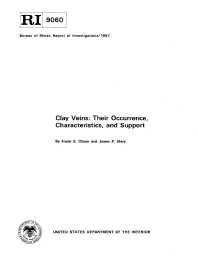Mining Publication: Clay Veins: Their Occurrence, Characteristics, and Support
Original creation date: January 1987
Clay veins found in coal mines have caused numerous injuries and fatalities. These structures plague all phases of mining, including entry development, pillar recovery, and panel extraction. Clay veins also increase production costs and may disrupt or halt mining. These detrimental aspects have prompted the Bureau of Mines to investigate the physical characteristics of and roof instability problems associated with clay veins. This was accomplished by observing and mapping clay veins in surface and underground mines. The occurrence and origins of clay veins were also investigated to determine predictive capabilities. The investigators found that clay veins normally occur in more stable, less rapidly subsiding coal basins. Clay veins result when tensile stresses develop fissures that are later infilled. These fissures can be propagated by compactional processes and/or tectonic stresses during and subsequent to coalification. The Bureau also found that associated faults, fractures, and slickenside planes commonly parallel clay veins and disrupt the lateral continuity of the immediate and, sometimes, main roof. When clay veins parallel or subparallel the direction of face advance, the roof is segmented into cantilever beams, causing unstable conditions. Consequently, the strata on either side of the clay veins should be bolted and strapped together to form a beam.
Authors: FE Chase, JP Ulery
Report of Investigations - January 1987
NIOSHTIC2 Number: 10005605
Pittsburgh, PA: U.S. Department of the Interior, Bureau of Mines, RI 9060, 1987 Jan; :1-19
See Also
- Analysis of Roof Bolt Systems
- Bolt Load Changes During Initial Face Advance and Cross-Cut Breakthrough
- The Effect of Standing Support Stiffness on Primary and Secondary Bolting Systems
- Factors Influencing Intersection Stability in U.S. Coal Mines
- The Introduction of Roof Bolting to U.S. Underground Coal Mines (1948-1960): A Cautionary Tale
- Preventing Falls of Ground in Coal Mines With Exceptionally Low-Strength Roof: Two Case Studies
- Roof Bolt Response to Shear Stress: Laboratory Analysis
- Short-Encapsulation Pull Tests for Roof Bolt Evaluation at an Operating Coal Mine
- Twenty-four Conferences; More than One-hundred and Seventy Papers; Understanding Roof Bolt Selection and Design Still Remains Priceless
- Zen and the Art of Rockbolting
- Content source: National Institute for Occupational Safety and Health, Mining Program


 ShareCompartir
ShareCompartir
